
Mole Creek Karst is a national park situated in the North of Tasmania, Australia, 168 km northwest of Hobart. It is located on the slopes of the Great Western Tiers to the east of the town of Mole Creek. It is the only national park in Tasmania created specifically to protect karst landforms. It is part of the Tasmanian Wilderness World Heritage Site.

The mountain plover is a medium-sized ground bird in the plover family (Charadriidae). It is misnamed, as it lives on level land. Unlike most plovers, it is usually not found near bodies of water or even on wet soil; it prefers dry habitat with short grass and bare ground. Its height is in the range of 5-9 inches, and length in the range of 8-10 inches ; and it weighs around 102 grams.
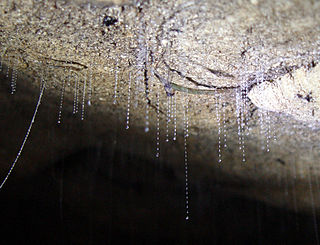
Arachnocampa is a genus of nine fungus gnat species which have a bioluminescent larval stage, akin to the larval stage of glowworm beetles. The species of Arachnocampa are endemic to Australia and New Zealand, dwelling in caves and grottos, or sheltered places in forests.

The Houston toad, formerly Bufo houstonensis, is an endangered species of amphibian that is endemic to Texas in the United States. This toad was discovered in the late 1940s and named in 1953. It was among the first amphibians added to the United States List of Endangered Native Fish and Wildlife and is currently protected by the Endangered Species Act of 1973 as an endangered species. The Houston toad was placed as "endangered" on the IUCN Red List of Threatened Species from 1986 to 2022, and has worsened to "critically endangered" since then, with fewer than 250 mature individuals believed to remain in the wild as of 2021. Their kind is threatened every day as they continue to suffer from a loss of habitat, extreme drought, and massive wildfires. Their typical life expectancy is at least 3 years but it may exceed this number.

The spotted gar is a freshwater fish native to North America that has an abundance of dark spots on its head, fins, and dart-like body. Spotted gar have an elongated mouth with many needle-like teeth to catch other fish and crustaceans. It is one of the smallest of the seven species of gar found in North America, growing 2–3 ft in length and weighing 4–6 lb (1.8–2.7 kg) typically. Gars have diamond-shaped, thick, enamel (ganoid) scales. The name Lepisosteus is Greek for "bony scale".
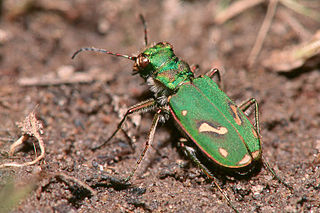
Cicindela ohlone, the Ohlone tiger beetle, is endemic to California. It was discovered in 1987 and named and described in 1993. C. ohlone is most closely related to Cicindela purpurea.
Texella reddelli, the Bee Creek cave harvestman, is a rare species of troglobitic harvestman that was added to the United States endangered species list in 1988, at the same time as six other species native to the karst ecosystem in Travis County and Williamson County, Texas, USA. They inhabit areas with near 100% humidity and constant temperatures, and they prey on springtails. Research on these creatures has been difficult since they can only be found underground. Their distribution is limited and unknown reproductive rates mean that it is possible they are especially susceptible to habitat destruction and other threats. Texella reddelli are found on both the North and South sides of the Colorado River.

The Kretschmarr Cave mold beetle is a small mold beetle.
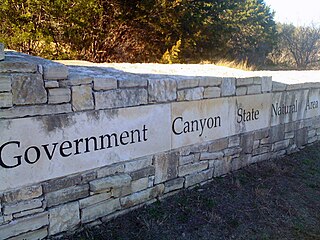
First opened to the public in October, 2005, Government Canyon State Natural Area (GCSNA) preserves 12,244 acres of rugged hills and canyons typical of the Texas Hill Country. It is designated a Natural Area, rather than a State Park, and therefore the primary focus is maintenance and protection of the property's natural state. Accordingly, access and recreational activities may be restricted if the Texas Parks & Wildlife Department (TPWD) deems such action necessary to protect the environment.

Stygoparnus is a monotypic genus of beetles containing the single species Stygoparnus comalensis, which is known by the common name Comal Springs dryopid beetle. This rare beetle is endemic to Texas in the United States, where it is known from two springs. It is a federally listed endangered species of the United States.

Texella reyesi is a rare species of arachnid known by the common name Bone Cave harvestman. It is endemic to Texas in the United States, where it lives in limestone caves in Travis and Williamson Counties. It is threatened by the loss of its habitat. It is a federally listed endangered species of the United States.
The Cokendolpher cave harvestman, Texella cokendolpheri, is a species of cave-living harvestman native to Bexar County, Texas. The original common name, the Robber Baron Cave harvestman, stemmed from the cave which the harvestman inhabits. The scientific name and the current common name honor the prominent arachnologist, James Cokendolpher, who identified the species. T. cokendolpheri is one of twenty-eight species within the North American harvestman genus Texella. The first formal description of the harvestman took place in 1992 and the species’ listing under the Endangered Species Act followed eight years later. Current threats to the species include habitat loss and interactions with invasive fire ants.
Cicurina madla is a rare species of spider in the family Dictynidae known by the common name Madla Cave meshweaver. It is endemic to Texas, United States, where it is known to originate from only eight or nine caves in Bexar County. This is one of a small number of invertebrates endemic to the karst caves of Bexar County that were federally listed as endangered species in the year 2000. Another spider from the caves was described as Cicurina venii, and given the common name Braken Bat Cave meshweaver. In 2018, it was synonymized with C. madla.
Cicurina baronia is a rare species of spider in the family Hahniidae known by the common name Robber Baron cave meshweaver. The species is endemic to the San Antonio, Texas area of the United States. It is one of nine species deemed the Bexar County Invertebrates, as all nine are found in similar cave environments in the central region of Texas. These species range in size from one millimetre to one centimetre. They are also eyeless or essentially eyeless and pale in coloration.

Rhadine is a genus of beetles in the family Carabidae, containing the following species:
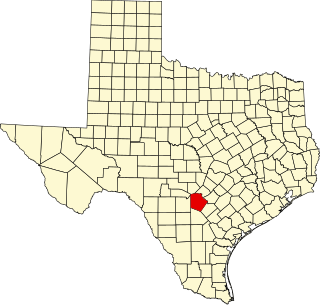
Rhadine infernalis is a species of troglobitic beetle of the family Carabidae. They are endemic to the county of Bexar, Texas. Within this county, R. infernalis has been found in 39 caves. There are 2 named subspecies of R. infernalis: R. infernalis infernalis and R. infernalis ewersi. There is a third possible subspecies that has not been officially described. R. infernalis was classified in 2000 as endangered under the IUCN Endangered Species Act of 1973, along with 8 other karst invertebrates in the same region. It has the widest known range of the endangered karst invertebrates.

Over 22,500 species of wildlife have been recorded in North Macedonia. Over 10,000 of these are insects, which include 3,000 beetle species and large numbers of Lepidoptera, flies, and Hymenoptera. Aside from insects, other large arthropod groups include Chelicerata and crustaceans. Among vertebrates, more than 300 species of birds recorded, although not all nest in the country. There are over 80 species of both fish and mammals, 32 reptiles, and 14 amphibians.
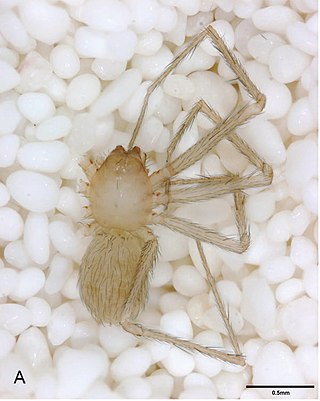
Tayshaneta microps, synonym Neoleptoneta microps, is a rare species of spider in the family Leptonetidae known by the common name Government Canyon bat cave spider. It is endemic to Texas in the United States, where it is known to be found in two caves in Bexar County. It is a troglobite, an animal which spends its entire life in caves. It is one of nine Bexar County troglobites which were listed as endangered species in 2000.

The Tooth Cave pseudoscorpion(Tartarocreagris texana) is a small cave-dwelling arachnid of the family Neobisiidae. The species was originally assigned to the genus Microcreagris, and then reassigned to Austalillocregris before arriving at its current genus, Tartarocreagris. The Tooth Cave pseudoscorpion has a small geographic distribution, known to occur in only two caves in Travis County, Texas. Additionally, it is tentatively identified in two nearby caves in Texas, but more research is necessary to accurately define the range where the species lives. There is little known about the biology, life cycle, and life history of the Tooth Cave pseudoscorpion due to a lack of research and study. Because of this, the Tooth Cave pseudoscorpion is listed on the IUCN Red List as data deficient. Under the Endangered Species Act, the Tooth Cave pseudoscorpion is listed as endangered. Recovery plans for the species focus mostly on preserving the karst ecosystem that the pseudoscorpions live in, especially including lessening human impacts on the environment.
Batrisodes venyivi, also known as Helotes mold beetle, is an eyeless beetle in the family Staphylinidae. They are found exclusively in the dark zones of caves in the Southwest region of Texas. More specifically, they have been found in eight caves throughout Bexar County, Texas. Similar species include the eight other Bexar County invertebrates, such as Rhadine exilis or Rhadine infernalis. All nine of these species are protected under the Endangered Species Act. Despite the efforts of a small number of researchers, the logistical challenges of accessing this habitat greatly limit the amount and type of information. Very little is known of the species' behavior, population trends, or general ecology.




















